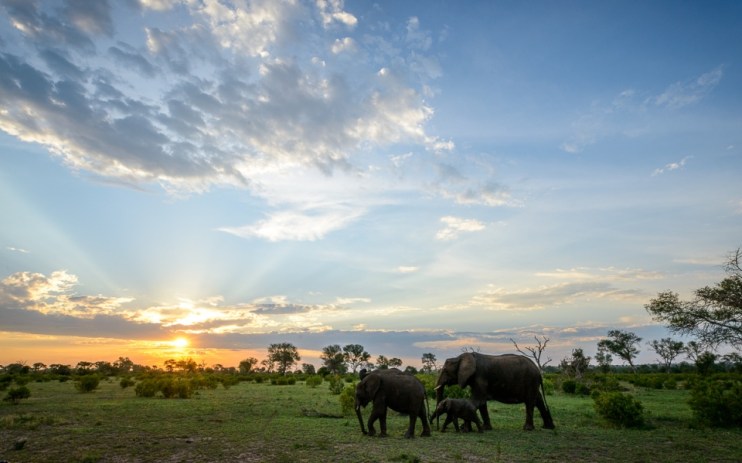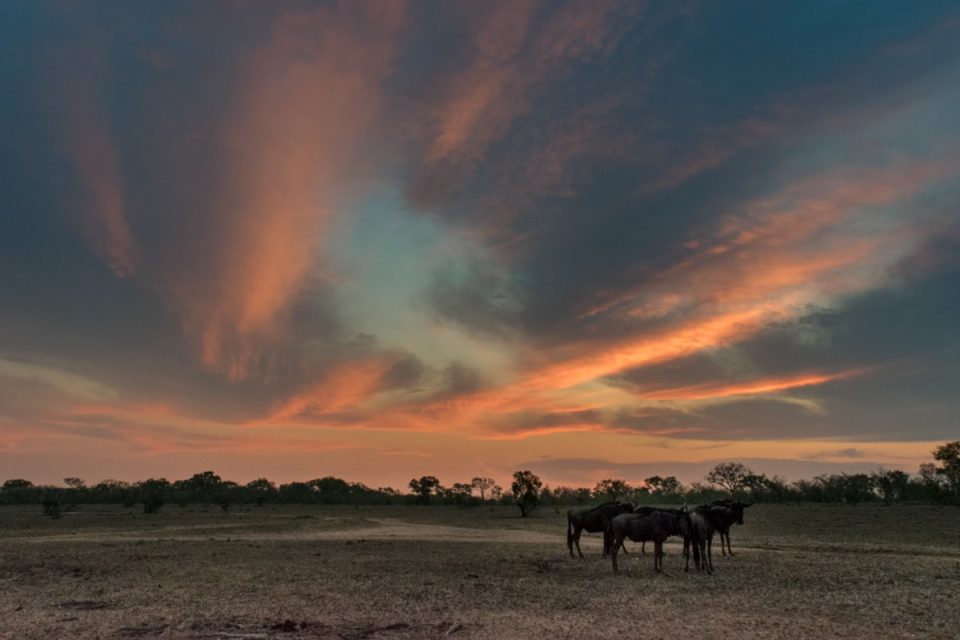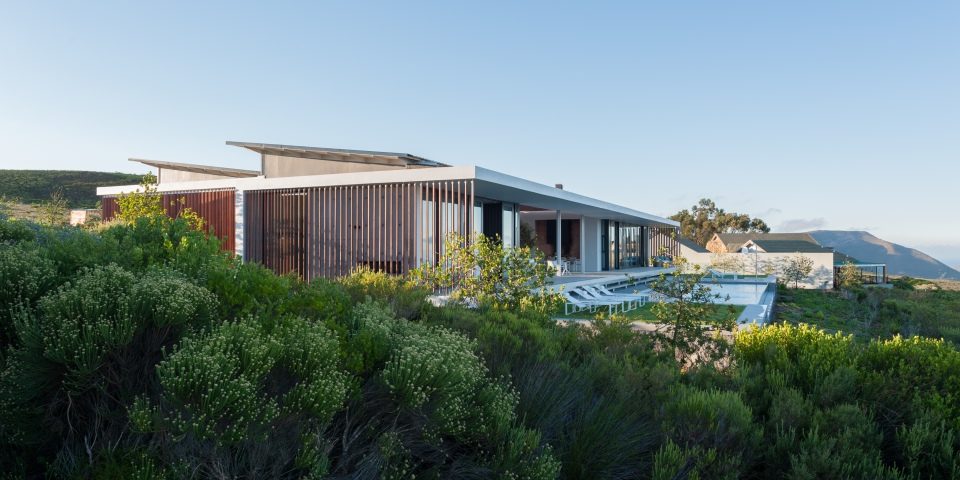Best of travel: South Africa’s finest nature reserves and safari

To tide us over until we’re able to travel again, we’re republishing classic travel stories from our archives. Today we revisit Adam Hay-Nicholls’ trip to South Africa in search of the ultimate nature reserve safari.
•••
There’s nothing particularly unusual for those used to a life of luxury about a five-star pool villa, except when said pool has a warthog drinking from it. My villa fronts straight onto the wild South African bush. We’re instructed not to step outside after dark, not even for a second, in case we get eaten. But this warthog is a friendly sort. She’s nonplussed that I’m lounging in the cool water before she scampers off in search of lunch.
Sabi Sabi Earth Lodge is situated in the middle of a private game reserve in Sabi Sands, flanked by Kruger National Park. These 400 square miles of land and the thousands of unfenced hectares beyond are home to lion, leopard, cheetah, hippo and rhino, aka the safari Big Five. Sculpted into a slope overlooking a natural watering hole, accessed via a hidden corridor and gazing onto uninterrupted bushveld, the Earth Lodge looks like a Brutalist Bond lair and has been described as the most environmentally-sensitive lodge in Africa.
It’s served by the tiny Skukuza airport, an hour’s Land Cruiser ride away and another hour’s flight from Johannesburg. Like most guests jetting in from Europe, I took 24hrs to acclimatise in Jo’Burg. It was to be a week-long adventure of contrasts, starting with the land safari before swapping the bush for the coast on South Africa’s Western Cape to see the ‘Serengeti of the Sea’ and its big marine five; whale, dolphin, penguin, seal and shark.
I’m given the Mandela Suite at Jo’Burg’s boutique and colonial Fairlawns hotel, so named because Madiba was a frequent visitor. The peaceful compound is located in a wealthy residential enclave. A plate of springbok carpaccio with wasabi mayonnaise and a treatment in the hotel’s stunning Balinese spa helps enliven the senses after the 11-hour flight from Heathrow.

The following morning, I catch the twice-daily South African Airways flight east to Skukuza and, within two minutes of tossing my suitcase into the back of a 4×4, I’ve already spotted a tower of giraffe. On the approach to the Earth Lodge, forewarned by the musky smell of a Turner Prize entry, I sight elephants snacking hungrily on Marula trees. A giant-eared ‘bull’ elephant had stood majestically upon the lodge’s roof earlier that morning, as other guests’ envy-inducing photos prove. Animals can stride out to the edge of the soil-coloured concrete structure given the architecture’s topographic design. It could give you a bit of a start over breakfast.
The cheetah looks so cute you want to go and give her a stroke but, as I keep reminding myself, that would be catastrophically stupid.
With just 13 suites, the Earth Lodge is extremely exclusive yet unmanicured, and everyone’s on first name terms. Typically, guests enjoy two safaris a day, each around three hours; one at the crack of dawn and the other in late afternoon and stretching into nightfall, when the beasts quit sun lounging and go on the hunt. During our first afternoon, we begin ticking names off our Big Five list. The first is a cheetah posing lazily in the amber light. She looks so cute you want to go and give her a stroke but, as I keep reminding myself, that would be catastrophically stupid.
We’re warned to stay sitting down in the open-top Land Cruiser and keep all limbs in the vehicle at all times. The predators see shapes rather than specifics, and if that shape changes the claws will emerge. It’s the teeth of a hippopotamus that we find later, yawning away in his waterhole, which really strike the fear of god into me, if only for his lack of dental hygiene.

After a morning safari you’ll be in need of a hearty breakfast, and I go for the Rancher’s Benedict, pairing a hollandaise-drenched muffin with cured venison and chakalaka, a spicy vegetable relish. For lunch, I recommend the ostrich wrap. During the evening safari, we stop for an aperitif, our ranger assembling an entire bar on the jeep’s bonnet. Amarula is the go-to tipple; a South African cream liquor. And like the denizens of Sabi Sabi we feast in the evening, either in the well-chosen 6,000 bottle-strong wine cellar or the outdoor ‘boma’, around a fire-pit. Kudu is a revelation; an adorable deer-like animal commonplace in this game reserve which, when grilled and served with a star anise jus, tastes like the finest fillet mignon.
Read more: Nightmare at 30,000 feet: can hypnotherapy cure a fear of flying?
At 6am, binoculars at the ready, we dust the sleep from our eyes and head back out into the wilderness with our tracker. Sabi Sabi is mostly silvery trees like bush willows and green, grey and ochre shrub. It’s not as visually stunning as, say, Kenya or Botswana, but the abundant wildlife more than makes up for it. We see several families of rhino, the little ones looking like they’ve shrunk in the wash. We see dazzles of zebra, herds of buffalo, and then a leopard strolls about four inches behind our jeep. It’s a paradise for twitchers, too, with yellow-billed hornbills, with beaks like bananas, a personal favourite. All that’s missing from my checklist is a lion.
Driving back to the airport after three days’ safari-ing, I’m already missing the Earth Lodge and wishing I’d spotted the king of the jungle when, right by the side of the road, there’s a pride of them! They’re chowing greedily on antelope.
The African penguins here, which make honking sounds like donkeys, will be extinct by 2026 unless something’s done.
From Skukuza I fly direct to Cape Town and drive two hours south along the coast to surf-spot Walker Bay. Surrounded by 2,500 rolling hectares of flora and fauna, the Grootbos Private Nature Reserve is home to 806 species of flower and plant, 100 of which are endangered, and 72 species of bird. The rule of not standing up in the safari truck doesn’t apply here, unless I could get mauled by an orchid.
Our guide, Tiaan, is a wonderfully potty Prince Harry lookalike with a Peter Pan personality, who started out as an animal behaviourist and switched to plants because they don’t run away. He’s fashioned himself a crown made of grass. You will never meet anyone so in love with nature as this man.

I’m bestowed a six-bedroom 1,000-square-metre villa, all modernist glass like Pierre Koenig’s Hollywood Hills houses, with panoramic views to the Atlantic beyond and an infinity pool straight out of a rap video. Previous occupants include Will Smith, Halle Berry and Brad Pitt (I’m assuming not at the same time). No doubt they made use of the private screening room. It also has a kitchen that would make any TV chef swoon, and I’m rustled up an ostrich fan fillet with date puree. Fine dining is on offer at the main Forest Lodge clubhouse or between the 1,000-year-old gnarled trees of the romantic ‘boma’, where the seafood is predictably sensational.
But despite the comparative flashiness when arriving from the game reserve, Grootbos (which is Afrikaans for ‘Big Forest’) is every bit as committed to preserving its nature and culture and supporting the community. Many guests get involved in, and contribute to, the property’s foundation, which helps 9,000 children from the area every year. One billionaire returns every summer to spend five hours a day in a bee-keeping suit. Another guest donated £100,000 over breakfast to help put locals through hospitality training and provide them with transport. For many, the holiday is as much about giving back as it is affording themselves a pleasurable experience.
A trip by boat to the nearby Dyer Island highlights the challenge. The African penguins here, which make honking sounds like donkeys, will be extinct by 2026 unless something’s done. More plentiful are the seals. There are 60,000 of them on this miniscule island, and they absolutely reek.
Tiaan takes us down to the prehistoric De Kelders coastal caves, proffering some edible limpets and then reaching for a hollow kelp horn – a makeshift vuvuzela – to signal, as they did in the Stone Age, that he’s spotted a school of whales. For the white southern right whale, with its enormous submerged shadow like that of a U-boat, the future is brighter than it seemed previously. Last year there were more calves born here than at any time in 39 years.
Grootbos and Sabi Sabi are determined, through expert conservation aided by well-heeled and eco-conscious guests, to ensure that nature continues to flourish in this spectacularly beautiful country. To see that they’re succeeding in such forward-looking and bold style makes a land and sea safari here all the more unforgettable.